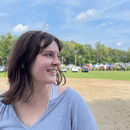It was 2011, I had bangs, and my fourth-grade year had just begun. My life back then felt like a cliché dream sequence we see in movies. Recesses blended into trading Pokémon cards became bowls of Cinnamon Toast Crunch and falling off my scooter, which ended in a bunk bed with a puppy cuddled up beside me. My fourth-grade self had very few worries. If one happened to materialize in my life, it certainly was not an existential concern. So, when I walked into my first fourth-grade science class, I expected nothing out of the ordinary.
My science teacher introduced our first unit of the year, Earth science. She began her lesson with the basics: the water cycle; tectonic plates; Pangea. Living in Washington State, my teacher naturally brought up our state’s active tectonic plates. Such movement created Mount St. Helens, Mount Rainier, and Mount Baker (in Oregon), all active volcanoes. To make matters worse, they were all overdue for an eruption. This was the moment I learned that the mountain I could see out the window every time we drove on the highway was actually a volcano that could blow up at any moment, killing me and everyone I ever knew. Of course, this was not completely factual, but my fourth-grade brain could not grasp the smaller, important details like how none of these volcanoes had erupted or even shown signs of activity in decades. All that crossed my panic-stricken mind was that I might die any moment from a natural disaster, something I could do absolutely nothing about.

When I got home from school that fateful day, I rushed to our family’s shared 2008 Dell desktop and did some research. Not only did I live near three incredibly dangerous volcanoes, but I discovered that I lived on the Cascadia Subduction Zone, the convergent zone of two major tectonic plates, the Juan de Fuca and North American plate. It is a Great Subduction Zone, which produces the largest recorded earthquakes of a 9.0 magnitude or greater. When the friction between these two plates releases, a severe earthquake will destroy the Pacific Northwest, my home. Following the earthquake will certainly be a similarly severe tsunami. The most terrifying part was that I learned that the odds of “The Big One” happening in my lifespan are roughly one in ten. Just like that, I contracted a fear of another natural disaster. My fourth-grade brain tried to wrap itself around the idea that I could be both burned alive by lava (this preceded my knowledge that those volcanoes were more likely to erupt volcanic ash than lava) and drowned in a tsunami.
It was a big day for me.
Over the years, I developed several plans of escape from these natural disasters that haunted me. The first was to move to the middle of the country nowhere near a fault line or large body of water. Then I learned about tornados. Another plan was to build a doomsday shelter that was impenetrable to weather. Unfortunately, I would quickly run out of air if I lived permanently underground. My last resort was to become an astronaut and get blasted into space to avoid Earth all together. What I did not account for is that I am more afraid of the unknown than the known. Finally, I accepted that there is no running from Earth. It has given us everything and it can take everything away.
I believe it was that moment in fourth-grade when I began to fear nature. It altered the way my world was orientated. Before, I was at the center and things seemed to revolve around me. Now, I am at the complete mercy of the planet I inhabit. I correlate this change in perspective to my ever-increasing fear of the climate crisis. There is a term for this kind of anxiety: eco-anxiety.
In 2017, the term “eco-anxiety” was coined by the American Psychological Association as “a chronic fear of environmental doom.” It is evidently a new phenomenon that has arisen in recent years, primarily in the Western hemisphere, alongside the growing environmental movement. Though only hearing about it a few weeks ago, I immediately resonated with the term. My original fear of the Earth came from fourth-grade science class, but that fledgling anxiety got significantly more complicated when climate change entered my frame of reference.
It is important to note the position of privilege I am speaking from. Eco-anxiety primarily presents itself in people unaffected by actual environmental disasters. Those living in island nations are having their livelihoods and homes taken from them by the rising sea levels. Australians are having to flee untamable bush fires, ruining everything on the east coast of the country. Some people do not have the luxury of discussing whether the climate crisis is real because they know it is. It has destroyed their lives as they know it.
Tectonic plates converging, volcanoes erupting, and massive tsunamis are all natural phenomena. Prolonged droughts, uncontrollable wildfires, and coastal erosion are symptoms of a climate crisis. Just as we cannot run from Earth, the Earth cannot run from us. We, humans, are the ones damaging the natural state of our planet. It never occurred to me that the Earth could be as scared of me as I am scared of it.
So, this is where my passion for climate activism ignites. Initially, it was hard to conceptualize what my actions meant in the grand scheme of things. Does switching from plastic straws to paper straws really save the turtles? How much does composting my leftovers really matter? Hence, visualizing Earth as a being like us, just as fearful but hoping to live compatibly with us, helped me. For as long as I live before a tsunami sweeps me away, I will treat the Earth with the same kindness. It is the least we can do.




